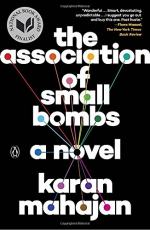|
This section contains 871 words (approx. 3 pages at 400 words per page) |

|
The Association of Small Bombs Summary & Study Guide Description
The Association of Small Bombs Summary & Study Guide includes comprehensive information and analysis to help you understand the book. This study guide contains the following sections:
This detailed literature summary also contains Quotes and a Free Quiz on The Association of Small Bombs by Karan Mahajan.
The following version of this book was used to create this study guide: Mahajan, Karan. The Association of Small Bombs. New York: Penguin Random House, 2016. Print.
The book starts with a bomb exploding in Lajpat Nagar, a market in Delhi. After the explosion is described in detail, we learn that the Khurana’s two young boys were killed in the blast. The narrator introduces us to Vikas and Deepa Khurana, a poor, liberal, Hindu couple in their forties. Vikas is a documentary maker, and Deepa bakes cakes to supplement their income.
The boys, 11 and 13, were supposed to take their sheltered, Muslim friend Mansoor home before going to the market. Instead, they decided to go to the market first with Mansoor. When the bomb went off, the two Khuranas were killed instantly. In a panic, Mansoor left the market and walked all through Delhi to his house.
Mansoor’s parents, Afsheen and Sharif Ahmed, are close friends with the Khuranas, and once the Ahmeds find out that their son is alive while the Khuranas’ sons are dead, they make an effort to comfort the grieving family. Vikas is overcome with guilt, and Deepa is obsessed with revenge.
The police announce that they have arrested three terrorists for the bomb, and the narrator switches over to the perspective of Shockie, a bomb-maker at JKIF, a cheap terrorist organization that he is contemplating leaving. Shockie’s superiors order him to go to Delhi and set off a bomb in Lajpat Nagar, and he reluctantly does so. When he gets back home, he has a fight about violence and martyrdom with his best friend and roommate, Malik, who is an intellectual, nonviolent member of JKIF. When Shockie heads off on another mission for JKIF, the police come and arrest Malik for the bomb at Lajpat Nagar.
Meanwhile, the Khuranas become frustrated with the court system in Delhi. The trial for the terrorists is put off again and again, so Deepa encourages Vikas to get back to work on his films. Deepa, however, gets to work on getting someone to let her inside the jail to see the terrorists. When, at last, she gets her way and is given the chance to sit down with Malik and watch his jailers beat him, she finds no satisfaction. Vikas is frightened that her disappointment is so deep that she might kill herself, but instead she gets pregnant and the couple gives birth to a daughter.
After the daughter is born, Deepa and Vikas are happy for awhile, but soon Vikas becomes depressed, and he is consumed with visions of the past.
In “Mansoor Ahmed’s Response to Terror,” the narrator switches over to the point of view of Mansoor and we learn all about his life after the bomb. Suffering from intense pain in his wrists and arms, and agoraphobia, his childhood had been ruined by the bomb. Things seem to turn around once he goes to college in California. But, shortly after 9/11, the pain in his wrist returns and he must go home to Delhi for treatment.
While back in Delhi, he joins a group called Peace For All, which is fighting for the rights of the terrorists that have been arrested for the bombing in Lajpat Nagar. Mansoor is not convinced by the group's ideologies at first, but after his parents suffer a financial loss and he learns that he cannot return to college, he becomes close with a member of the group, Ayub. Ayub converts Mansoor into a strong Muslim believer, and Mansoor begins to believe that India is in desperate need of a revolution. Although he thinks he has found God, Mansoor becomes jealous of Ayub’s relationship with a female member of Peace For All.
In “Ayub Azim’s Response to Terror,” the narrator switches over to Ayub. After a failed protest and a bad breakup with his girlfriend, Ayub goes back to his family’s farm. Bitter and alone, he buys a gun with the intention of killing Modi. Unable to go through with the assassination, he decides to kill himself. Unable to go through with the suicide, he finds a group of terrorists led by Shockie and sets out to detonate a bomb in Sarojini Nagar, a market in Delhi.
In the last section, we learn that Vikas and Deepa are members of a group they call the Association of Small Bombs, which reaches out to victims of terrorism and fights for their rights. When they hear about the bomb in Sarojini Nagar, they go to the hospital to meet the victims and meet Ayub, who injured himself in the blast.
When Mansoor learns that Ayub is in the hospital, he goes with his parents to visit him. It soon becomes clear to him, however, that Ayub is responsible for the bomb.
Ayub disappears from the hospital, and Shockie is arrested for his involvement in the Lajpat Nagar bombing. Under torture, he names Ayub. Unable to find Ayub, who is dead, the police arrest and torture Mansoor, who, though innocent, admits to the Sarajini Nagar bombing. Twelve years later, he is released for lack of evidence, and he goes home to his parents’ house, never leaving again.
Read more from the Study Guide
|
This section contains 871 words (approx. 3 pages at 400 words per page) |

|



